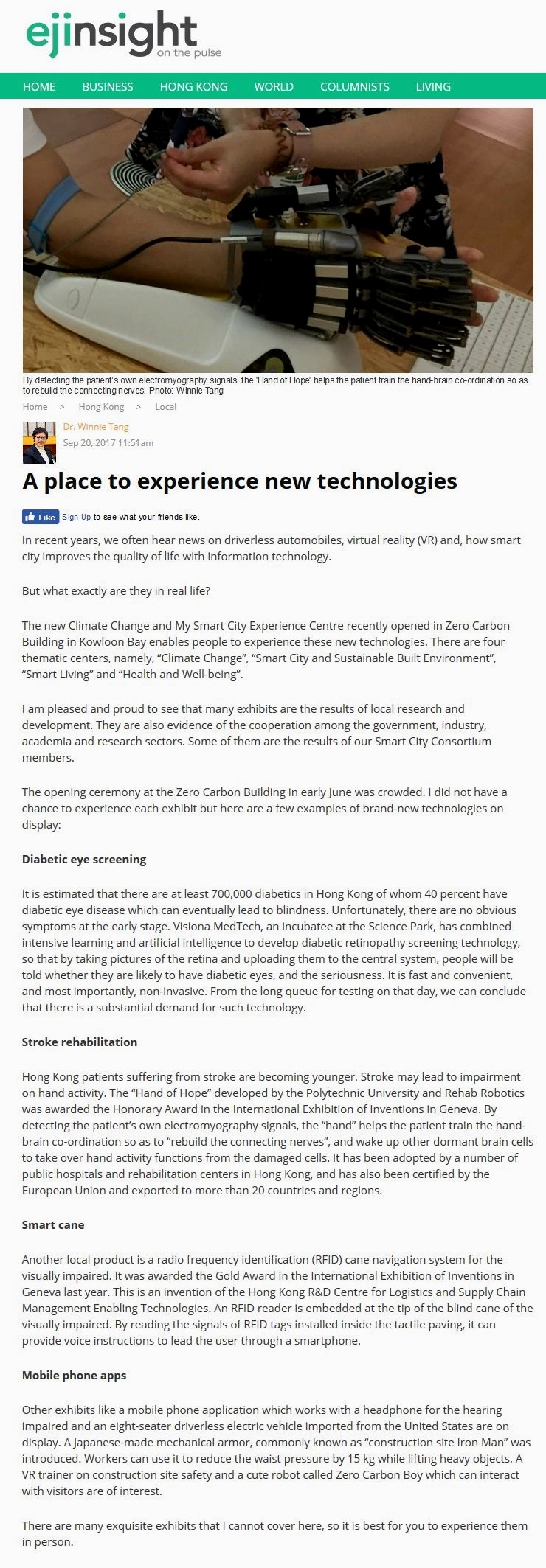網上版請按此

A place to experience new technologies
In recent years, we often hear news on driverless automobiles, virtual reality (VR) and, how smart city improves the quality of life with information technology.
But what exactly are they in real life?
The new Climate Change and My Smart City Experience Centre recently opened in Zero Carbon Building in Kowloon Bay enables people to experience these new technologies. There are four thematic centers, namely, "Climate Change", "Smart City and Sustainable Built Environment", "Smart Living" and "Health and Well-being".
I am pleased and proud to see that many exhibits are the results of local research and development. They are also evidence of the cooperation among the government, industry, academia and research sectors. Some of them are the results of our Smart City Consortium members.
The opening ceremony at the Zero Carbon Building in early June was crowded. I did not have a chance to experience each exhibit but here are a few examples of brand-new technologies on display:
Diabetic eye screening
It is estimated that there are at least 700,000 diabetics in Hong Kong of whom 40 percent have diabetic eye disease which can eventually lead to blindness. Unfortunately, there are no obvious symptoms at the early stage. Visiona MedTech, an incubatee at the Science Park, has combined intensive learning and artificial intelligence to develop diabetic retinopathy screening technology, so that by taking pictures of the retina and uploading them to the central system, people will be told whether they are likely to have diabetic eyes, and the seriousness. It is fast and convenient, and most importantly, non-invasive. From the long queue for testing on that day, we can conclude that there is a substantial demand for such technology.
Stroke rehabilitation
Hong Kong patients suffering from stroke are becoming younger. Stroke may lead to impairment on hand activity. The "Hand of Hope" developed by the Polytechnic University and Rehab Robotics was awarded the Honorary Award in the International Exhibition of Inventions in Geneva. By detecting the patient's own electromyography signals, the "hand" helps the patient train the hand-brain co-ordination so as to "rebuild the connecting nerves", and wake up other dormant brain cells to take over hand activity functions from the damaged cells. It has been adopted by a number of public hospitals and rehabilitation centers in Hong Kong, and has also been certified by the European Union and exported to more than 20 countries and regions.
Smart cane
Another local product is a radio frequency identification (RFID) cane navigation system for the visually impaired. It was awarded the Gold Award in the International Exhibition of Inventions in Geneva last year. This is an invention of the Hong Kong R&D Centre for Logistics and Supply Chain Management Enabling Technologies. An RFID reader is embedded at the tip of the blind cane of the visually impaired. By reading the signals of RFID tags installed inside the tactile paving, it can provide voice instructions to lead the user through a smartphone.
Mobile phone apps
Other exhibits like a mobile phone application which works with a headphone for the hearing impaired and an eight-seater driverless electric vehicle imported from the United States are on display. A Japanese-made mechanical armor, commonly known as "construction site Iron Man" was introduced. Workers can use it to reduce the waist pressure by 15 kg while lifting heavy objects. A VR trainer on construction site safety and a cute robot called Zero Carbon Boy which can interact with visitors are of interest.
There are many exquisite exhibits that I cannot cover here, so it is best for you to experience them in person.
Dr. Winnie Tang
Honorary Professor, Department of Computer Science, The University of Hong Kong